
Atomic Explorer
Atomic Explorer
Shot meteoroids
Collect Protons, Neutrons and Electrons
Shot meteoroids
Collect Protons, Neutrons and Electrons
Game description
In brief
Learning objective
In Atomic Explorer, players can learn about atoms and the periodic table. By building atoms, the players are encouraged to navigate and learn about the periodic table, as well as to strengthen their knowledge about the nucleus, protons, neutrons and electrons.
Game objective
In each game round, the objective is to build 12 atoms, by collecting protons, neutrons and electrons and fusing them together. The scoring system is designed to encourage collaboration, as well as exploration and understanding of the periodic table. Each game round has a specific set of mission goals, such as: finding elements in a specific group, or unstable isotopes. Atoms that align with the round-specific mission goals will achieve a higher score. The goals yield a diminishing return, except for the discovery of a new element. Upon mission completion, the team is presented with a diploma, which can be saved via a QR code.
Attributes

Age 10+

15-60 Minutes

Science

Collaborative
Detailed description
Gameplay
The game begins with a view into space. To start the game the players must first shoot one or more meteoroids to get the protons, neutrons and electrons needed to construct atoms. To shoot the meteoroids, the players should hold a finger on top of the meteoroid for one second, after which the meteoroid shatters into protons, neutrons and electrons.
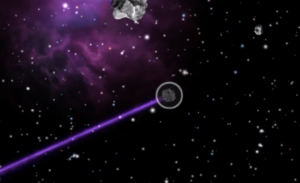
How to build atoms
Move your finger around the screen to collect protons, neutrons and electrons into atoms. The numbers displayed around the collected particles show the amount of protons and electrons collected, as well as the atomic weight. To create an atom, you need at least one proton and can only collect an amount of neutrons and electrons that produce a known isotope of that element.
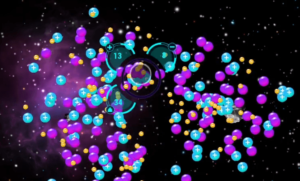
How to form atoms: Nucleosynthesis
When the collected particles match a known isotope, they can be fused into an atom. To start the fusion process, hold your finger still for 5 seconds. There are three animations for the fusion process: Big Bang, Supernova and neutron star merge. Each animation corresponds with the formation process of different atoms, and after the animation, the complete atom will show up.
Big Bange: H and He
Supernova: Li to Zr
Neutron star: Nb to Og
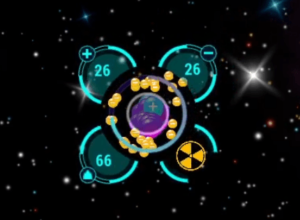
Examine the atom (optional)
You can examine the properties of fused atoms by tapping on them to open an info box, and to close you simply tap again.
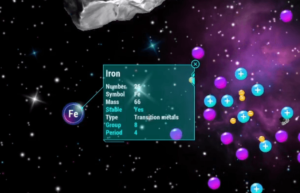
Docking atoms
When the atoms have been built, they must be moved to the dock at the bottom. When all 12 atoms have been docked, the spaceship will travel to the next mission or in the case of the last mission finish the game.
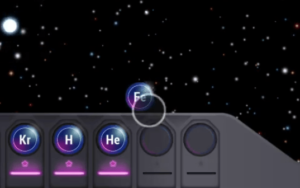
Periodic table
Use the “periodic table” button in the right-hand corner of the screen, to access the periodic table overview. The page contains an overview of the elements that the players already have found in this game session. The page also shows properties for each of the elements in the periodic table, such as stable isotopes, type (alkali metals, alkaline earth metals, lanthanoids, actinoids, transition metals, post-transition metals, metalloids, reactive non-metals, noble gasses), as well as the group and period that the element belongs to. Understanding these properties is essential to achieve a high score in the game.
Game mission and scoring
Each level has a specific set of mission goals, and building atoms that match the goals increases the score. A mission goal can be to find elements within a specific group in the periodic table, e.g. group 14. Finding Carbon (C) will yield points for finding a new atom, as well as points for atoms belonging to group 14. Finding another element in group 14 will yield a smaller bonus, as there is a diminishing return on the goals, except for a new element found. It is possible to find atoms which fulfil several mission goals at once thereby increasing the score. The scoring system is designed to encourage building and finding new elements, rather than simply continuously building the same atoms.
The following properties listed can serve as mission goals:
- Period: a period is a horizontal row in the periodic table, where elements have the same number of electron shells.
- Group: is a vertical column in the periodic table, where elements have similar chemical properties and the same number of valence electrons.
- Series: are specific sets of consecutive elements that share common properties, such as the lanthanides and actinides.
- Stable atoms: have a balanced ratio of protons to neutrons and do not undergo radioactive decay, maintaining a constant structure over time.
- Unstable atoms: have an imbalance in the number of protons and neutrons, leading to radioactive decay as they seek stability.
- Beginning with: elements beginning with a specific letter
See result
When the game is finished, or when exiting to the menu, a results page will be shown. The results are shown in a diploma format, which can be saved to a mobile device via the QR code (remember to save the downloaded image on the mobile device).
The result page shows a rank from 4 to 1, where 1 is the highest achievable rank. The rank is based on the achieved score compared to the maximum possible score for this particular game. The maximum score is different from game to game, hence the score from different games cannot be compared directly.
Detailed description
Settings
Mission count
The players can choose from 1 to 10 missions, a single mission allows for a quick 5-10 minute game. A full 10-mission game makes it possible for the players to find and discover all of the atoms in the periodic table.
